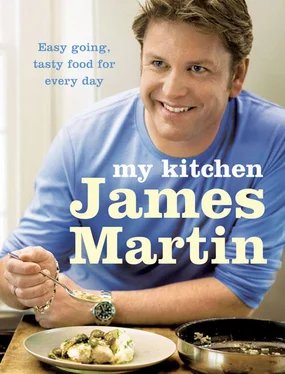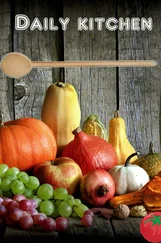Salt and black pepper
1 lemon, cut into wedges, to serve
Crusty bread, to serve
My chef, Chris, came up with this idea while experimenting in the kitchen. I liked the combination of these ingredients so much that I put it on the menu at my bistro. If you can’t find dill-marinated salmon, just use regular smoked salmon instead.
Thinly slice the rhubarb lengthways and cut into very fine sticks, the size of matchsticks. Place in a bowl of iced water and leave for 20 minutes.
Place the pickled ginger and juice in a bowl, add the lime zest and juice along with the olive oil, then season, to taste, with salt and pepper.
Remove the rhubarb from the iced water, mix into the bowl with the dressing and stir in the chives. Slice up the salmon and arrange on a board or platter, or divide between plates. Serve with the rhubarb salad, some lemon wedges to squeeze over the salmon, and chunks of crusty bread on the side.
Grilled halibut with champ and lemon caper butter
Serves 4
500g (1lb 2oz) floury potatoes, peeled and cut into quarters
110ml (4fl oz) milk
50g (2oz) butter
150g (5oz) spring onions, chopped
4 × 150g (5oz) halibut fillets, all bones removed
1 tbsp olive oil
110g (4oz) caper berries or capers
Peeled segments of 4 lemons, plus the juice of 1 lemon
1 tbsp chopped flat-leaf parsley
Salt and black pepper
Halibut is a meaty fish, full of flavour and with very few bones. If you can’t get caper berries, use small capers (caper buds) instead, but if they’re in salt or brine, rinse well in hot water before using.
Put the potatoes in a large saucepan, cover with water and add a good pinch of salt. Bring to the boil and cook for 20–25 minutes, then drain the potatoes and return to the pan, which should no longer be over the heat.
Pour the milk into a small saucepan and heat until nearly boiling. Crush the potatoes with a fork or potato masher until they form a chunky mash, then slowly add the hot milk, stirring all the time.
Melt half the butter in a frying pan over a medium heat, tip in the spring onions and sauté for about 2 minutes. Add these to the mash, then season well with salt and pepper and set aside.
Season the halibut with salt and pepper and drizzle with olive oil. Place in a non-stick frying pan over a high heat and cook for 3–4 minutes on each side, or until the fish starts to turn golden-brown. Remove from the heat and set aside.
Add the remaining butter to a medium-sized saucepan set over a high heat. When it has turned nut brown in colour, add the caper berries and the juice of one lemon. Season, then remove from the heat and add the lemon segments and parsley.
Place some champ on each plate with a piece of halibut at the side. Spoon the lemon caper butter over the top and serve.


Mackerel with caramelised radishes
Serves 4
16 baby white onions, peeled and left whole
16 radishes
1 tbsp runny honey
2 tsp cumin seeds
4 mackerel, gutted and washed
2 banana shallots, peeled and sliced
2 lemons, sliced
1 bunch of coriander
1 bunch of chives
½ bunch of thyme
50ml (2fl oz) olive oil
This recipe was inspired by a trip to France, where I visited a great market right on the seafront. The fishing boats were moored up alongside the market stalls, which were laden with fresh fish – in particular, mackerel, which is unbeatable when eaten fresh and cooked simply. I was also impressed by the crisp, vibrant radishes on sale. Here I’ve found a way to combine the two.
Place the onions and 110ml (4fl oz) water in a large non-stick saucepan. Bring to the boil and allow to cook for 5 minutes, or until tender, then add the radishes and cook for a further 2–3 minutes.
Add the honey and cumin seeds and cook for a further 5–6 minutes. The colour of the radishes will gradually start to run and form a glaze. When nearly all the liquid has evaporated, remove the pan from the heat.
Preheat the oven to 180°C (350°F), Gas 4. To prepare the mackerel, place 4 sheets of foil on a work surface – each sheet about the size of a newspaper. Divide the shallots, lemons and herbs between the pieces of foil, placing a pile in the middle of each sheet. Place the mackerel on top and score the fish with a sharp knife. Drizzle with the olive oil and a tablespoon of water and fold the foil over to form small parcels.
Place the parcels on a baking tray, put in the oven and cook for about 8–10 minutes. Remove from the oven, open up the parcels and transfer the fish to plates. Gently reheat the onion and radish mix, divide between the plates and serve.
Cod with clams, curly kale and wild garlic
Serves 4
4 tbsp rapeseed or extra-virgin olive oil
150g (5oz) butter
4 × 150g (5oz) cod fillets, skin on
400g (14oz) small, fresh clams, in shells
2 shallots, peeled and finely chopped
200ml (7fl oz) perry (cider-like drink made from pears) or cider
225g (8oz) curly kale, stalks discarded
110g (4oz) wild garlic leaves, or 110g (4oz) fresh spinach and 2 cloves of garlic, peeled and chopped
Zest of 1 lemon
3 tsp finely chopped chives
Salt and black pepper
When buying cod, go for thicker fillets from larger fish, as these have the best flavour and don’t break up too much during cooking. Wild garlic can be found in woodland and by the side of the road; the leaves should be picked before the heads flower. If you can’t find it, use spinach and chopped cloves of garlic instead.
Preheat the oven to 190°C (375°F), Gas 5. Set an ovenproof pan or roasting tin on the hob over a high heat and, when the pan is hot, add the rapeseed or olive oil and 25g (1oz) butter. When the butter has melted, fry the cod fillets for 2–3 minutes on each side, until they are golden-brown all over.
Transfer the pan to the oven and roast the fish for 5 minutes until just cooked through. Remove the pan from the oven, cover with foil and set aside to rest.
Meanwhile, put the clams in a colander and wash thoroughly under running water, discarding any with broken shells or those that don’t close when they are tapped against the side of the colander.
Set a large saucepan over a high heat and, when hot, add the clams, shallots and most of the perry or cider. Lower the heat and simmer, uncovered, for 2–3 minutes, until the clams have opened and the liquid has slightly reduced.
Clean out the colander and place it over a similar-sized bowl. Pour the clams and cooking liquid into the colander so that the liquid drains through to the bowl. Return the liquid to the pan and set the clams aside. Discard any which haven’t opened during cooking.
Читать дальше














